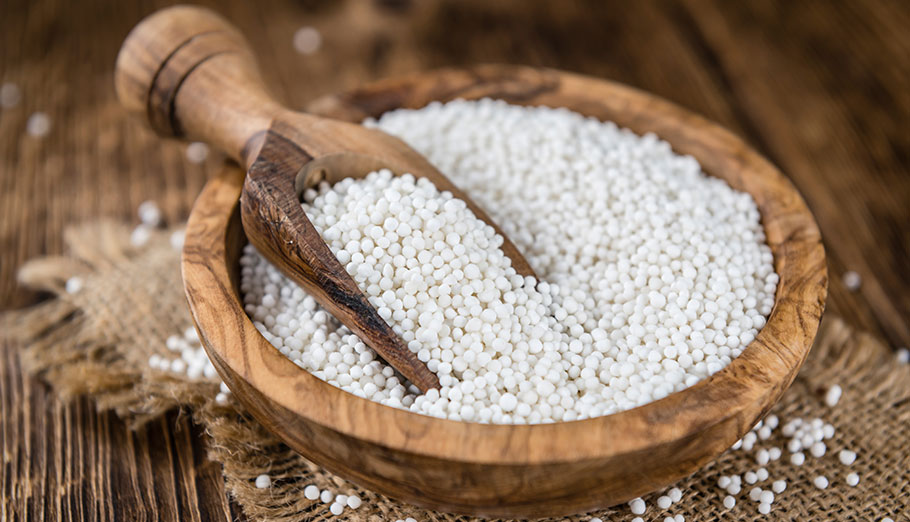Tapioca

Overview (Gluten Free)
Made from the root of the cassava, a native South American shrub, tapioca flour is a widely used thickener for cakes, muffins, pie fillings, soups, sauces, and gravies as well as for improving the texture of baked goods. In case you’re wondering, the name “tapioca” is derived from a South American term for the cassava plant—tipióka. The plant is also known as “manioc,” and sometimes you will find it sold as such.
Although tapioca flour is quite starchy, the fact it is gluten-free and has a neutral taste has made it one of the most popular alternative flours for those with gluten sensitivity and gluten allergy. It is particularly useful as a thickener because it doesn’t coagulate or separate when refrigerated or frozen. Many people wonder what the difference between tapioca flour and tapioca starch is. In fact, there is no difference—they are just different terms for the same product.
Nutrition
Tapioca flour is essentially starch. This makes it an ideal filler for a wide variety of recipes. It is also used in combination with flours (usually gluten-free flours). However, tapioca is over 88% carbohydrate by weight, so a little goes a long way.
Note: Weight of a cup (or partial cup) of flour varies depending upon whether it is lightly sprinkled into a measuring cup or compacted. Most recipe measurements are based on sifted flour as a way to arrive at a more uniform measurement.
Gluten Content & Allergen Information
Those with Celiac disease or sensitivity to the proteins in wheat gluten will find tapioca flour a perfect alternative for many dishes. Additionally, anyone concerned about the use of genetically engineered corn crops (92% of corn grown in the USA is genetically engineered) will find tapioca flour a welcome alternative to cornstarch.
Nutrition Facts
| Serving Size | 1 Cup |
| Calories | 544 |
| Total Fat 0g | 0% |
| Cholesterol 0mg | 0% |
| Sodium 0mg | 0% |
| Carbohydrates 135g | 45% |
| Dietary Fiber 1g | 4% |
| Total Sugars 5g |
| Protein 0g |
| Vitamin D 0mcg | 0% |
| Calcium 30mg | 3% |
| Iron 2mg | 12% |
| Potassium 0mg | 0% |
* The % Daily Value (DV) tells you how much a nutrient in a serving of food contributes to a daily diet. 2,000 calories a day is used for general nutrition advice.
Diet Compatibility
Paleo Diet
The Paleo Diet seeks to emulate the hunter-gatherer diet of our stone-age ancestors. The emphasis is on wild plants and meats similar to what ancient man would have consumed. As such, dairy products, refined sugar and processed oils are off limits. While many Paleo Diet followers also avoid grains, there is ample archaeological evidence to show that grains were part of Paleolithic era man’s diet.
Compatibility with Tapioca Flour:
Compatible. The cassava root and its edible leaves have been a part of South American culture for many centuries. It is highly likely it was a part of early man’s diet in that region of the world.

Mediterranean Diet
This diet seeks to emulate the diets of those living along the Mediterranean coast, with an emphasis on fresh fruits and vegetables, seafood/fish at least twice a week, limited servings of poultry, and only occasional sweets and red meat.
Compatibility with Tapioca Flour:
Not Compatible

Gluten-Free Diet
As the name suggests, the gluten-free diet eliminates all foods with gluten. Although most of those on a gluten-free diet are on it out of necessity—either due to severe wheat allergies or Celiac disease—many have embraced a gluten-free diet as being healthier.
Compatibility with Tapioca Flour:
Compatible

Macrobiotic Diet
Although there are many versions of macrobiotic diets, the common thread is that they emphasize natural, whole foods, grown locally and organically. Whole grains, vegetables, legumes, fruits, seeds and nuts, and occasional seafood are all integral to the diet. Red meats, dairy, poultry, eggs and processed foods are off the menu.
Compatibility with Tapioca Flour:
Not Compatible

Acid Alkaline Diet
This diet aims to restore the slightly alkaline state of the body, which is believed to be ideal. By focusing on a diet high in vegetables, fruits, sprouted grains, lentils, almonds and soy products, the goal is to have a balance of 80% alkalizing foods and 20% acid forming foods.
Compatibility with Tapioca Flour:
Possibly Compatible – Tapioca Flour is condiered to a moderate level acid-forming food

Low-Carb Diet
As the name suggests, this diet focuses on reducing carbohydrates in the diet to lose weight. The theory is that by staying away from high-carb foods like pasta and bread and eating low carb, high fiber vegetables and fruits instead, your body will go into ketosis and you will lose weight. This diet is sometimes referred to as a ketogenic diet.
Compatibility with Tapioca Flour:
Compatible in limited amounts

Atkins Diet
The Atkins Diet is a historically popular low carb diet, instructing dieters not to worry about their calories but to monitor and minimize their intake of sugar and carbohydrates. According to Dr. Atkins, depriving the body of its primary energy sources causes the body to burn fat.
Compatibility with Tapioca Flour:
Compatible in limited amounts

“We love the mill! We use it every day for things from bread, to pastry and it is phenomenal. The biggest selling point for me was the fineness since that would mean we can really do some great pastry with it in addition to bread. It definitely has been great!"
BEN FROM NORTH CAROLINA

